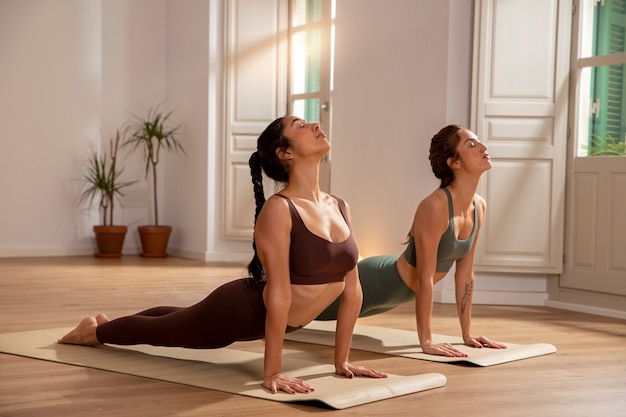
Yoga isn’t just about flexibility. Anna Magee believes it can boost memory, heart, and bone health.
Brits are spending £790 million annually on yoga, becoming obsessed with poses like downward dogs. Despite some quirky trends like naked yoga and dog yoga, scientific studies highlight yoga’s real benefits. Researchers at UCLA found that a three-month yoga and meditation course outperformed memory exercises in reducing age-related brain decline and improving sleep in breast cancer survivors.
When Lucy Edge, a 53-year-old former advertising executive, suffered from deep depression, she turned to yoga instead of antidepressants. After a six-month break in India learning yoga, she returned happier and more content. Inspired by her experience, Lucy wrote three books and created Yoga Meds on her website, listing over 300 clinical trials showing yoga’s benefits for various conditions like arthritis, insomnia, and obesity.
If crossword puzzles and Sudoku have been your only brain exercises so far, it might be time to try yoga. The UCLA study on adults over 55 showed that 12 weeks of yoga and meditation improved spatial and visual memories, reduced depression and anxiety, and increased stress resilience. A single gentle Kundalini yoga session of one hour per week plus daily 20-minute Kirtan Kriya meditation sufficed in the study.
Yoga is also linked to heart health. A review published in the European Journal of Preventative Cardiology in 2014 indicated that yoga could lower heart disease risks similar to conventional exercises like brisk walking. Reducing stress through yoga helps lower blood pressure and heart rate, thus reducing the chances of blood clots.
Dr. Mike Knapton from the British Heart Foundation notes yoga’s benefits for people with anxiety, stress, and depression, often experienced by those who have had cardiac events. Yoga has shown to improve blood pressure, cholesterol, and weight, all of which are heart disease risk factors.
Beginners can benefit from gentle yoga poses recommended by experts like Charlotte Watts and Anna Ashby. Restorative yoga, which uses supports like bolsters and cushions, is particularly effective in reducing stress by allowing the nervous system to relax.
For people with back pain, yoga can be incredibly beneficial. Physiotherapist Sarah Shone integrated yoga classes into a rehabilitation program with an 87% success rate in pain reduction. The National Institute of Clinical Excellence suggests yoga for lower back pain, and Shone aims to train more physiotherapists in using yoga clinically.
Yoga also helps prevent incontinence by strengthening pelvic floor muscles and can increase bone density being weight-bearing. For beginners with health issues, gentle styles like Hatha or Iyengar yoga are recommended. Consulting a doctor can help determine if subsidized yoga classes are an option.
Choosing the right yoga mat depends on where you’ll use it, how often you’ll carry it, and your height. Investing in a thick yoga mat can protect joints and provide comfort. Healthista recommends the Elephant Cork Yoga mat from Valka Yoga for its eco-friendliness, comfort, and design. Perfect for those who sweat, cork mats become grippier when wet and are naturally antimicrobial and odor-resistant. They also come with a carry strap and warranties.
For additional support, a yoga block like Valka’s matching elephant design block can help with more challenging poses. Though heavier than foam blocks, cork blocks offer better stability and grip.
No matter your flexibility, there’s a yoga style for you. Try Yin or Restorative yoga for a relaxed, supportive experience, Vinyasa Flow for energetic sequences, Iyengar for precise alignment, Anusara for upbeat, alignment-focused flow, or Yoga Therapy for healing specific conditions.
Whatever your experience level, yoga offers numerous health benefits and can be tailored to suit individual needs.